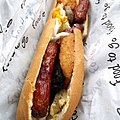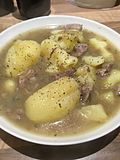Irish dishes
| English name | Irish name | Image | Description |
|---|---|---|---|
| Bacon and cabbage | Bágún agus cabáiste |  | Unsliced back bacon boiled together with cabbage and potatoes. [1] |
| Barmbrack | Bairín breac |  | A leavened bread with sultanas and raisins. |
| Batter burger | A fast food consisting of a beef patty cooked in batter, similar to a battered sausage. A Wurly burger (spellings vary) is a batter burger served with a hamburger bun and toppings. | ||
| Black pudding | Putóg dhubh |  | Sausage made from cooked pig's blood, pork fat, pork rind, pork shoulder, pork liver, oats, onion, rusk (wheat starch, salt), water, salt, pimento and seasoning (rusk, spices). Picture shows slices of black pudding (dark) and white pudding (light). |
| Boxty | Bacstaí |  | Finely grated raw potato and mashed potato mixed together with flour, baking soda, buttermilk and occasionally egg, then cooked like a pancake on a griddle pan. |
| Breakfast roll | Rollóg bhricfeasta |  | A bread roll filled with elements of a traditional fry-up, designed to be eaten on the way to school or work. It can be purchased at a wide variety of petrol stations, local newsagents, supermarkets and eateries throughout Ireland and Great Britain. Often served alongside the chicken fillet roll, which is filled with "plain" or "spicy" fried chicken breast fillet. |
| Champ Also known as "poundies" | Brúitín |  | Mashed potatoes and chopped scallions (spring onions) with butter and milk. |
| Chicken fillet roll | Rollóg sicín | A bread roll filled with a fillet of processed chicken. It is a ubiquitous deli item in Ireland, served hot. | |
| Coddle | Cadal |  | Layers of roughly sliced pork sausages, bacon (usually thinly sliced, somewhat fatty back bacon), with sliced potatoes and onions. Exclusive to Dublin. |
| Colcannon | Cál ceannann |  | Mashed potatoes with kale or cabbage. Not very popular in Ulster. |
| Crubeens | Crúibín |  | Boiled pigs' feet. |
| Curry chips | Sceallóga curaithe [2] |  | Chips and a curry sauce. At Chinese takeaways in Ireland, a 3-in-1 consists of curry chips served with fried rice (a 4-in-1 or higher typically adds a portion of chicken balls and/or chicken wings). |
| Drisheen | Drisín | A type of black pudding, often made from lamb's blood, and soft set. In Cork, it is usually served alongside boiled tripe and onions. [3] | |
| Farl (or soda farl) | Farla |  | A traditional quick bread or cake, roughly triangular in shape. Particularly associated with Ulster. |
| Fried bread | Arán friochta |  | Bread fried in bacon fat. |
| Full breakfast Also known as "full Irish", "Irish fry" or "Ulster fry" | Bricfeasta friochta |  | Rashers, sausages and eggs, often served with a variety of side dishes such as fried mushrooms, soda bread and puddings. |
| Garlic cheese chips | Sceallóga le cáis agus gairleog [4] | Chips with garlic mayonnaise and melted cheddar cheese. | |
| Goody | Gudaí | A dessert dish made by boiling bread in milk with sugar and spices. | |
| Gravy chips | Chips covered with gravy. Very popular in Ulster | ||
| Gur cake | Cáca gur |  | A pastry confection associated with Dublin. |
| Irish stew | Stobhach/ Stobhach Gaelach |  | A traditional stew of lamb or mutton, potatoes, carrots, onions, and parsley. |
| Jambon | Siamban [5] |  | A folded puff pastry filled with diced ham, egg and cheese, served warm at delicatessens and often eaten at breakfast or elevenses. |
| Limerick Ham | Liamhás Luimnigh | A particular method of preparing a joint of bacon within the cuisine of Ireland. The method was originally developed in County Limerick, Ireland. | |
| Irish seafood chowder | Seabhdar |  | A particular method of preparing a seafood soup, often served with milk or cream. |
| Mashed potato | Brúitín |  | Prepared by mashing freshly boiled potatoes with a potato masher, fork, ricer, or food mill, or whipping them with a hand beater. Butter and milk are sometimes added. |
| Pastie | - |  | A round, battered pie of minced pork, onion, potato and seasoning. Exclusive to Ulster. |
| Potato bread | Arán prátaí |  | A flat bread made from potato and flour, dry-fried. A key component of the Ulster fry. |
| Scone | Scóna |  | A scone is a single-serving quick bread/cake, usually made of wheat, barley or oatmeal with baking powder as a leavening agent and baked on sheet pans. A scone is often lightly sweetened and occasionally glazed with egg wash. [6] |
| Shepherd's pie | Pióg an aoire |  | Shepherd's pie is a lamb or mutton and vegetable mixture with gravy topped with mashed potato. |
| Skirts and kidneys | - |  | A stew made from pork meat, including the kidneys, bladder, and liver. |
| Snack box | Sneaicbhosca [7] [ better source needed ] | A common menu item at fish-and-chip shops, consisting of chips served in a box with two wings or drumsticks of fried chicken.[ citation needed ] A "lunch box" includes three pieces of chicken, and a "dinner box" four.[ citation needed ] | |
| Soda bread (known in most of Ulster as wheaten bread) | Arán sóide |  | A variety of quick bread traditionally made in a variety of cuisines in which sodium bicarbonate ("baking soda" or "bread soda") is used as a leavening agent instead of the more common yeast. The ingredients of traditional soda bread are flour, bread soda, salt, and buttermilk. Sometimes raisins are added to make it sweeter. |
| Spice bag Also known as "spice box" | Mála spíosrach/ Bosca spíosrach |  | A fast food sold in Chinese takeaways and fish-and-chip shops, consisting of chips, crispy chicken pieces, peppers, onions and spices mixed together in a bag or box. |
| Spice burger | Burgar spíosraí [8] | A patty containing beef, beef fat, cereals, onions and spices; coated in breadcrumbs and served as fast food. | |
| Spiced beef | Mairteoil spíosraithe |  | A cured and salted joint of rump steak or silverside beef, which is traditionally served at Christmas or the New Year. |
| Taco chips | Chips topped with taco mayonnaise, cheese, and a chilli of beef mince, tomatoes, peppers and onions. | ||
| White pudding | Putóg bhán |  | Very similar to black pudding, but containing no blood. Contains pork meat and fat, suet, bread, and oatmeal formed into a large sausage shape. Picture shows slices of white pudding (light) and black pudding (dark). |